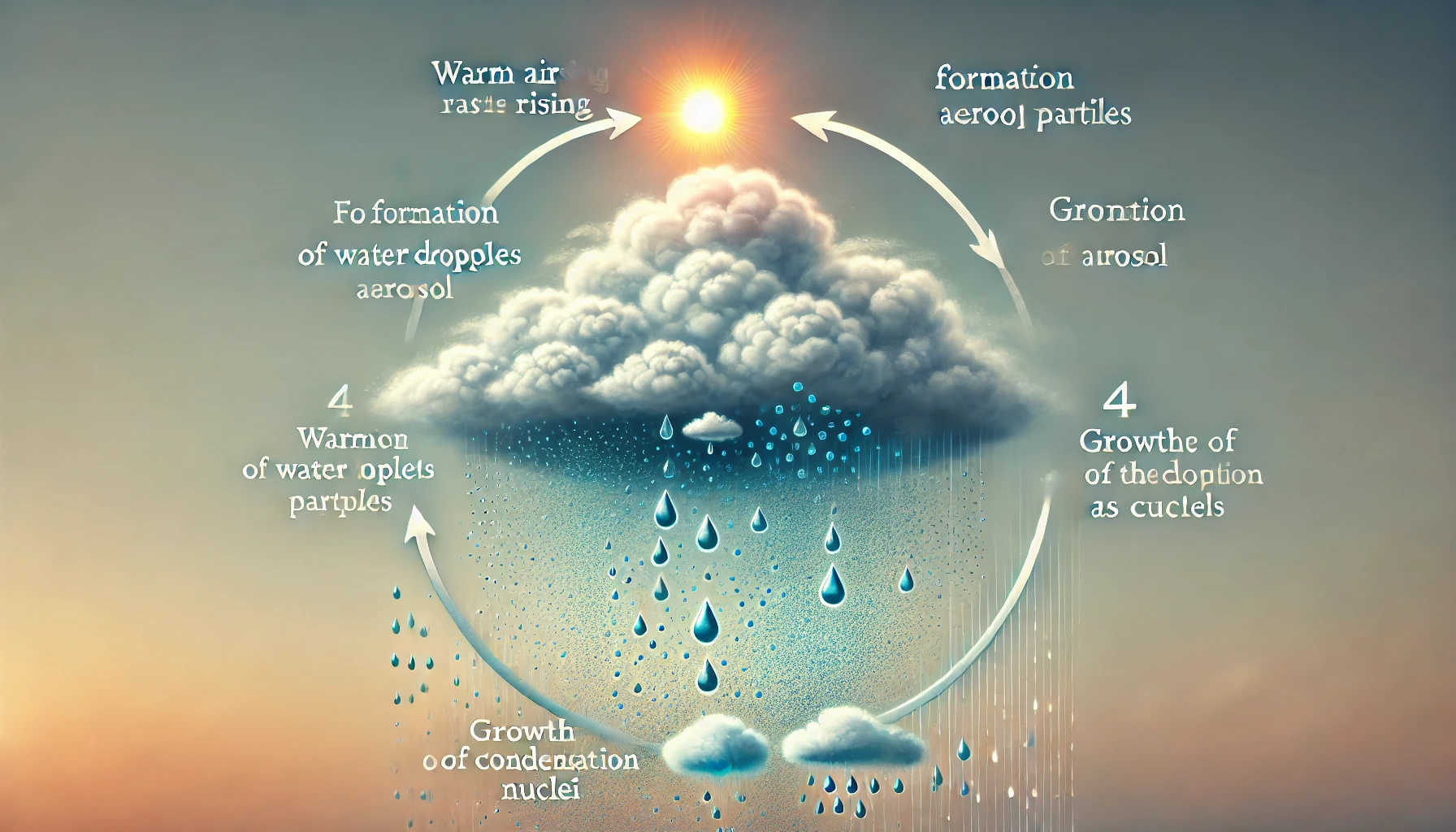The atmosphere reaches saturation when it has the maximum amount of water vapor it can hold at a given temperature, and when the saturation water vapor pressure is reached, condensation begins and clouds form. Aerosol particles act as condensation nuclei, creating water droplets even if the atmospheric water vapor pressure is not saturated, which leads to precipitation.
When the atmosphere has the maximum amount of water vapor it can hold at a given temperature, it is said to be saturated. The pressure exerted by the water vapor is called the saturation water vapor pressure, and this value is greater at higher temperatures. The saturated vapor pressure of the atmosphere is the critical point at which condensation begins. Once condensation begins, water vapor turns into water droplets and clouds form.
The process of cloud formation is complex and multi-step, and clouds can form when the water vapor pressure present in the atmosphere exceeds the saturated water vapor pressure, usually due to cooling temperatures. These droplets continue to collide, merge, and grow to form clouds. Many factors affect the formation and growth of water droplets.
At the beginning of formation, water droplets are extremely small and spherical in shape, so they have a large curvature. The greater the curvature, the more difficult it is for water droplets to grow. In a water droplet with a large curvature, surface tension makes it difficult for surrounding water vapor molecules to enter the droplet, while making it easier for water molecules on the surface of the droplet to evaporate into the surrounding water. The smaller the water droplet size, the more water vapor pressure is required because of the increased surface area that water vapor molecules must cover to enter the droplet. Also, when water vapor molecules leave the surface of the water droplet, the surface area is reduced, making it easier to evaporate. For this reason, water droplets with greater curvature require higher vapor pressure for condensation to occur. In this way, the curvature of water droplets affects the amount of vapor pressure required for water droplet growth, which is called the curvature effect.
However, in nature, water droplets are formed even when the atmosphere is not saturated with water vapor. This is because various particulates suspended in the atmosphere, called aerosols, help to form water droplets. Many of these aerosols are hygroscopic, meaning they can act as nuclei for condensation of water vapor even at relative humidity below 100%. Atmospheric condensation is mostly naturally occurring, but it can also occur as a result of air pollution. Condensation nuclei provide a surface on which water vapor molecules can easily condense, so larger aerosols are more effective at forming water droplets than smaller ones. The formation of water droplets from hygroscopic aerosols into condensation nuclei is called inhomogeneous nucleation.

Let’s take a look at one example of how inhomogeneous nucleation causes water droplets to form by adsorbing water vapor molecules even when the atmosphere is not saturated. When sea salt (sea salt) particles in the atmosphere act as condensation nuclei, the process of water droplet formation dissolves the sea salt, i.e., the water droplets produced by the condensation of water vapor act as a solvent to dissolve the solute. When a solute is dissolved in the water droplet, the surface of the water droplet is composed of water molecules and solute molecules, so there are fewer water molecules than in pure water. Therefore, the evaporation rate of water molecules from the surface is smaller than that of pure water. As a result, the water vapor pressure required for growth is lower than that of pure water in the case of a water droplet containing sea salt. The amount of water vapor pressure required for water droplets to grow depends on the concentration of the solution, which is known as the solute effect.
This condensation process affects not only cloud formation in the atmosphere, but also precipitation. When the water in a cloud becomes large enough, it begins to fall under the influence of gravity, which is how rain occurs. The process of precipitation involves a number of complex physical phenomena, and different atmospheric conditions can affect the amount and form of precipitation. For example, if there is a lot of dust or other particulates in the atmosphere, the number of condensation tubes can increase, leading to the formation of more water, which can lead to an increase in precipitation. On the other hand, if there are fewer particulates in the atmosphere, it may be difficult for the water in the clouds to grow large enough, resulting in a decrease in precipitation.
As such, cloud formation and precipitation phenomena are closely related to complex atmospheric dynamics, and understanding them plays an important role in weather forecasting and climate change prediction. The study of atmospheric water vapor and condensation processes has become increasingly important in recent years as climate change has led to more frequent extreme weather events around the world. In-depth research and analysis of atmospheric water vapor dynamics, cloud formation mechanisms, and precipitation processes are needed to accurately predict and respond to the effects of climate change.
 I’m a blog writer. I want to write articles that touch people’s hearts. I love Coca-Cola, coffee, reading and traveling. I hope you find happiness through my writing.
I’m a blog writer. I want to write articles that touch people’s hearts. I love Coca-Cola, coffee, reading and traveling. I hope you find happiness through my writing.